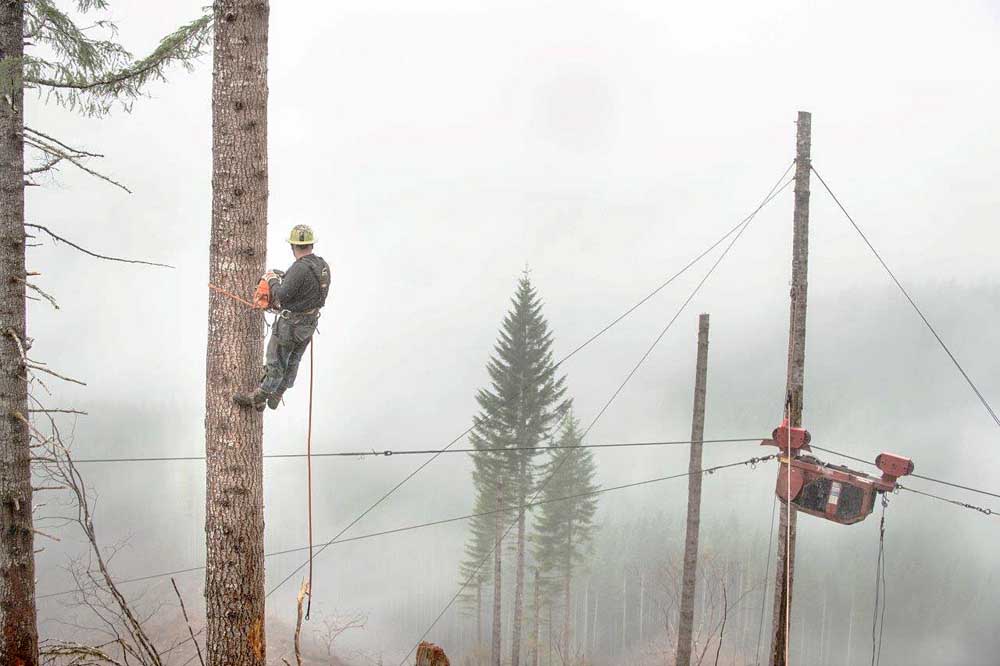Willamette Valley logger keeps close eye on detail
Published 5:45 am Tuesday, March 10, 2020

- A misty scene from a logging operation.
Harvesting trees from the steep slopes of Western Oregon is rarely a logistically simple feat, but this job was a particular doozy.
Cutting roughly 4 million board-feet of timber from the remote 105-acre parcel near the Siletz River’s north fork would require logger Jim Gahlsdorf and his team to negotiate inclines of up to 80% — a rise of 80 feet for every 100 feet across.
Trending
They’d also be dealing with a “blind lead,” which involves hoisting logs by cable over a ridge that obstructs the crew’s field of vision, while keeping dirt from tumbling into the creeks flowing between the hillsides below.
“That whole unit was a challenge, and many operators I’ve talked to said they wouldn’t have even bid on it because it was so difficult,” said Dave Thompson, a stewardship forester with the Oregon Department of Forestry who ensured the operation complied with logging regulations.
Operator of the year
Gahlsdorf successfully pulled off the job last year while going above and beyond the environmental standards of the Oregon Forest Practices Act, which prompted Thompson to nominate his company for ODF’s 2019 Northwest Oregon Operator of the Year.
His logging outfit recently won the respected award, which recognizes Gahldorf’s deft handling of that especially demanding operation as well as his overall commitment to preserving water quality and preventing erosion and landslides.
“When they log a unit, it looks about as good as you can expect from a logging job,” Thompson said. “They know what the rules are, but they go one step better.”
Trending
Though it was just one logging job of many, the unit near the north fork of the Siletz River exemplifies Gahlsdorf’s skill in reconnaissance and preparation.
Planning is critical
“Planning is probably what I do best,” he said.
For example, the location was in the “middle of nowhere” and would require hours of driving one way if a machine broke down and needed a spare part, Thompson said. Gahlsdorf anticipated that problem and brought replacements to the site.
“That in itself is a big challenge,” he said. Since that particular area had already been logged decades ago, Gahlsdorf took advantage of aerial photos taken in the 1960s to see what he could learn from his predecessors.
Though the pictures did provide some insights, Gahlsdorf can’t replicate methods from the past such as building roads that would displace copious amounts of soil and threaten water quality.
“There’s an expense to building roads, but keeping it out of the creeks is the thing,” he said.
Technology helps
Apart from the historical photos, Gahlsdorf also relied on modern images created with Lidar, an optical system that uses lasers to accurately depict the topography of the landscape.
With that data, he was able to lay out three points on the unit to best position the yarder tower, which pulls logs up the hillside by cable to the landing, where they’re stacked for hauling.
His crew members are equipped with tablets showing their exact location, as provided by satellite data, which improves the team’s situational awareness of the logging operation.
“It’s been great to see where we can drag logs and where we shouldn’t drag logs,” Gahlsdorf said.
Technology also assists in laying out the angle of the cables between the yarder tower and the anchor, as well as any trees that serve as intermediate supports.
When a ridge blocks a cable from lining up directly with an anchor, it’s necessary to use a tree on that ridge to support the cable above the ground. That way, the log can be suspended high enough to avoid the “plowing effect” that causes erosion.
“The only way to get over that is with that ski lift type of action,” Gahlsdorf said.
A computer program helps him calculate how much weight the cables will be able to support and otherwise plan out the specifics of how the logs are moved to the landing.
Back in the day, Gahlsdorf was taught to take such measurements using a jeweler’s chain and fishing weights, but now the calculations are performed using software.
“You’ve got some really good tools you can use, if you choose to,” he said.
Conducting such planning in the comfort of his office saves a tremendous amount of time compared to doing it on-site, since the travel alone can eat up hours of the day. Moving equipment around is also a lot cheaper on a computer than in real life.
“I can explore a lot more opportunities,” Gahlsdorf said. “Just moving that tower is ridiculously expensive.”
As a forestry student at Oregon State University, Gahlsdorf spent summers working logging jobs and soon became enthralled by the noise and thrashing of machines contending with dirt and logs.
Hooked on logging
After spending roughly a decade as a consultant, mostly surveying and measuring standing timber inventories, he started his own logging company in 1985.
Much of his job these days involves scrutinizing potential logging jobs with an eye toward keeping his employees close enough to sleep in their own beds at the end of the day.
“You’re always out looking and bidding, seeing how well you’re matched to a particular job,” Gahlsdorf said.
The recent Northwest Oregon Operator of the Year award reflects his company’s aspiration to do right not only by the rules, but by the landscape as well.
“My people take pride in their work if I take pride in my work,” he said.








